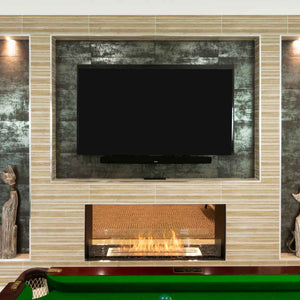What is a Bio Ethanol Fireplace

A bioethanol fireplace is a modern and eco-friendly alternative to traditional wood-burning or gas fireplaces, offering a perfect blend of charm, warmth, and sustainability.
Utilising bioethanol, a renewable and clean-burning fuel derived from crops such as sugar cane or maize, these fireplaces generate a real flame and heat without the need for a chimney or flue.
The smokeless heat bioethanol produces makes it an ideal option for creating a cosy atmosphere in your home.
Many bioethanol fireplaces come with simple designs that make them easy to set up and use; all you need to do is unpack the fireplace, fill it with bioethanol fuel, and enjoy a real flame within minutes.
In addition to their ease of use, these fireplaces are versatile and can be integrated into various room designs, from modern self-builds to more traditional interiors.
Key Benefits of a Bioethanol Fireplace
- Bioethanol fireplaces are eco-friendly alternatives that utilise clean-burning, renewable fuel from crops like sugar cane or maize.
- These fireplaces don't require a chimney or flue, providing versatile design options and easy installation.
- Bioethanol fireplaces offer a smokeless heat source, allowing for a safe, warm and cosy atmosphere in your home

Understanding Bio Ethanol Fireplaces
Bio ethanol fireplaces are a modern and eco-friendly alternative to traditional wood-burning or gas fireplaces. These innovative appliances utilise bioethanol, a renewable and clean-burning fuel, to produce real flames and heat without needing a chimney or flue.
Bioethanol is a sustainable "green fuel" from crops such as sugar cane or maize. It is manufactured by fermenting waste plant products' sugar and starch elements, then distilling and purifying the resulting liquid to enhance the alcohol content.
When burned, bioethanol produces a clean, smokeless form of heat, making it ideal for use indoors.
Various types of bio ethanol fireplaces are available, including wall-mounted, double sided and many other designs.
Each variety offers unique advantages in terms of aesthetics and functionality. Regardless of the design, operating a bio ethanol fireplace is quite simple. You only need to follow these three steps:
-
Add bioethanol fuel into the burner box using a specially designed no-drip squeezy bottle.
-
Light the fumes. Within minutes, a beautiful natural flame will add instant cosiness to your home.
Operational Principle
A bioethanol fireplace offers an efficient and aesthetically pleasing alternative to traditional wood-burning fireplaces. To understand its operational principle, you'll need to know the key components and process of generating heat.
The main component of a bioethanol fireplace is its burner. This is where the fuel, bioethanol, is stored and burned.
One of the main advantages of a bioethanol fireplace is that it doesn't require a chimney, as it produces little to no smoke. This allows for easy installation and adds flexibility regarding where to place your fireplace in your home.
Regarding heat output, a bioethanol fireplace can generate a significant amount of warmth. Additionally, the flame can be easily controlled using the closing rod supplied with your bioethanol fireplace.
Components and Installation
There are several types of bioethanol fireplaces, including freestanding, wall-mounted, and recessed models. Each type has its own set of components and installation requirements.
-
Freestanding bioethanol fireplaces are portable units that can be placed anywhere in your home. These fireplaces typically consist of a burner box, a fuel reservoir, and a protective frame.
-
Wall-mounted bioethanol fireplaces can be hung on most walls, providing a sleek and modern focal point. These fireplaces consist of a burner box, fuel reservoir, mounting brackets, and a surrounding frame. To install a wall-mounted unit, follow the manufacturer's guidelines for securing the mounting brackets to the wall and attach the frame and burner box.
-
Recessed bioethanol fireplaces are designed to be integrated into a wall or other structures, creating a seamless appearance. These fireplaces usually contain a burner box, a fuel reservoir, and a frame to fit the recess.
Regardless of the type of bioethanol fireplace you choose, their easy installation process is a key benefit.
They don't require any electrical connections, and due to their clean-burning nature, there's no need for a chimney or venting system.
A bioethanol fireplace offers an attractive and eco-friendly heating solution for your home. With their range of styles and simple installation, you can easily find the perfect fireplace to suit your needs.

Safety Considerations
This section discusses essential safety considerations for bioethanol fireplaces, including handling flammable elements, ensuring proper ventilation, and appropriate extinguishing methods.
Handling Flammable Elements
Bioethanol fuel is a flammable material. To ensure your safety when using a bioethanol fireplace:
-
Always store the fuel container in a cool, dry place away from direct sunlight and any ignition source.
-
Only use approved bioethanol fuel specifically made for bioethanol fireplaces.
-
Never overfill the fireplace's fuel reservoir, which can lead to spillages and accidents. Always adhere to the manufacturer's guidelines for fuel capacity.
-
Avoid adding fuel to the fireplace when it's lit or hot. Wait for the fireplace to cool down entirely before refilling.
Ventilation
Bioethanol fireplaces are designed to be used indoors without external ventilation.
They burn bioethanol fuel that produces water vapour and carbon dioxide, eliminating the need for a chimney or flue.
Ensure you follow the manufacturers guidelines, which usually stipulates a room size for the safe use of a bioethanol fireplace.
To create a comfortable and safe environment, follow these simple steps:
-
Ensure that the room housing the fireplace is well-ventilated with fresh air entering the space.
-
Do not install the fireplace in confined spaces or areas with limited air circulation.
-
Regularly inspect and maintain your bioethanol fireplace to avoid potential safety hazards and ensure optimal performance.
Impact on Air Quality
Bioethanol fireplaces have advantages over traditional wood- or gas-burning fireplaces.
As you use a bioethanol fireplace, the primary emissions are water vapour and CO2 - there is no smoke or particulates. This means that these fireplaces are less damaging to indoor air quality.
Also, the CO2 emitted during combustion originates from the plants used to produce the bioethanol fuel, making it a more sustainable option.
Comparing with Other Types
When considering a bioethanol fireplace for your living space, you may wish to compare it with other heating options such as gas and electric fireplaces.
-
Gas Fire: Gas fires are a popular choice due to their ease of use and realistic flame effect. They typically provide more heat output than bioethanol fireplaces but rely on a natural gas connection, which may not be available in all locations. Additionally, a gas fire usually requires a chimney or flue system for proper ventilation, while bioethanol fireplaces do not.
-
Electric Fireplaces: Electric fireplaces are another low-maintenance option that does not require ventilation. They offer a wide range of heating and visual effects, but their heat output is generally lower than both gas and bioethanol fireplaces. Electric fireplaces are also dependent on the availability of electrical sockets and may not provide the same degree of ambience as a real flame.
While gas fires and electric fireplaces are popular choices for indoor heating, bioethanol fireplaces offer an eco-friendly and flexible alternative that does not require a chimney or flue for ventilation.
Bioethanol as a Fuel
Bioethanol fuel, also known as biofuel or bio-ethanol fuel, is a sustainable and eco-friendly alternative to traditional fossil fuels. Produced from crops such as sugar cane, maize, and other waste plant products, this renewable fuel serves as a clean and efficient source of energy.
The production process of bioethanol fuel involves fermenting the sugar and starch elements of the waste plant products, followed by distilling the resulting liquid to purify and enhance its alcohol content. This liquid fuel is typically available in bottles of 1 litre or more, ready for use in bioethanol fireplaces.
Using bioethanol as a fuel ensures a clean burn with no emissions, making it better for the environment.
When it comes to bioethanol fireplaces, the process is simple. Just pour the bioethanol fuel into the burner box and light the fuel with the manufacturer’s gas lighter. In no time, you'll have a beautiful natural flame without any mess or fumes.
Heat Generation and Control
Bioethanol fireplaces are an excellent choice for those who want to enjoy the warmth and ambience of a real flame without the need for a chimney or flue.
They generate heat by burning bioethanol fuel. These fireplaces can produce between 2 to 4 kW (6,800 to 13,600 BTU) of heat, with some larger models capable of generating up to 15 kW (51,100 BTU) or more.
Controlling the heat and flame size of your bioethanol fireplace is just as straightforward. Most models come with a closing rod or a similar tool, which allows you to adjust the flame to your desired level.
In addition, some more advanced fireplaces offer remote controls, making it even more convenient to manage the heat output.

Environmental Effect
Bioethanol fireplaces offer a more sustainable and environmentally friendly option for heating your home. The primary reason behind this is that they utilise bioethanol fuel, which is a renewable energy source derived from organic materials.
When compared to traditional fossil fuels, bioethanol fuel production has a significantly lower impact on the environment. It helps reduce the demand for non-renewable energy sources and lessens the release of harmful greenhouse gases.
In terms of emissions, bioethanol fireplaces produce only a minimal amount of carbon dioxide and a negligible amount of water vapour.
This is a stark contrast to the substantial amounts of smoke, fumes and particulates emitted by wood, coal and gas fires. The reduced emissions from a bioethanol fireplace also mean that you don't need a chimney or a flue system in your home, as there are no harmful by-products to vent.
When using a bioethanol fireplace, the heat generated is free from smoke, odours and other pollutants, which results in better air quality within your living space. This is particularly beneficial for those with respiratory issues or allergies, as it provides a cleaner and more comfortable environment.
Versatility and Design
Bio ethanol fireplaces offer a high level of versatility in both design and functionality. One such advantage is the portability of these fireplaces.
Unlike traditional wood or gas fireplaces, which require fixed installations, bio ethanol fireplaces can be easily moved to suit your changing décor and spatial needs.
A key element of a bio ethanol fireplace's design that contributes to its versatility is the lack of need for a chimney or venting system. This allows for greater freedom in where you choose to place your fireplace, as well as opening up more possibilities for innovative and eye-catching designs.
Hanging bio ethanol fireplaces, for example, are a sleek and modern option that can provide an impressive focal point in your living space. These fireplaces can be suspended from the ceiling, creating a unique touch without taking up valuable floor space. The captivating flames can draw attention and serve as a conversation piece when entertaining guests.
With a diverse range of designs available, bio ethanol fireplaces can seamlessly fit into a variety of interior styles. Whether you prefer a traditional or contemporary look, there is a design that will complement your home. The flames provided by the bio ethanol fuel create a warming ambience whilst acting as a stylish focal point in any room.
Regulatory Framework and Standards
Bioethanol fireplaces have become increasingly popular due to their eco-friendly nature and ease of use.
Although there are no direct safety standards specifically for bioethanol fireplaces in the UK, it is essential for you to exercise caution and follow manufacturer guidelines when using your fireplace. the fireplace is installed and avoid placing any flammable items nearby.
When buying bioethanol fuel, it is crucial to choose a reputable supplier to ensure the quality and safety of the fuel you're using. While bioethanol fireplaces produce no smoke, it is still essential for you to maintain and clean your fireplace regularly to prevent any potential hazards.
It's important to remember that bioethanol fireplaces are not regulated appliances under the UK's Building Regulations, as they don't require a chimney or flue.
However, you may benefit from discussing integration and safety concerns with a professional installer or an experienced professional.

Frequently Asked Questions
How do bioethanol fireplaces function?
Bioethanol fireplaces work by burning bioethanol fuel, which is a renewable, clean, and smokeless source of heat. To use a bioethanol fireplace, you simply pour the fuel into the burner and light it with a standard gas lighter or extended taper. In just a few minutes, you will have a beautiful natural flame, providing warmth and ambience to your space. These fireplaces do not require any flues, vents, or chimneys, making them easy to install and maintain.
What are the drawbacks of using a bioethanol fireplace?
While bioethanol fireplaces offer a clean and efficient way to heat your home, they do have some drawbacks. One of these is the cost of fuel, which can be more expensive than traditional wood or gas fireplaces. Moreover, depending on the size of the fireplace and the room, the heat output might not be enough to warm large spaces effectively.
Another downside is that bioethanol fireplaces produce water vapour as a byproduct of combustion, which can lead to dampness in enclosed spaces if there is not enough ventilation. Additionally, since bioethanol fireplaces are open-flame systems, they may not be suitable for households with children or pets as there is a higher risk of burns or accidents.
Are bioethanol fires efficient for heating?
Bioethanol fires can produce a good level of heat, depending on the size of the fireplace and the room itself. However, it is essential to choose the right fireplace for your space and ensure it is positioned correctly to maximize its heating efficiency.
Keep in mind that, while bioethanol fireplaces can provide ample heat for small to medium-sized rooms, they may not be as efficient for heating larger areas, especially when compared to traditional wood or gas fireplaces. Remember to consider the fuel cost and availability in your area before deciding on a bioethanol fireplace.
What types of bioethanol fireplaces are available?
There are various styles and designs of bioethanol fireplaces available, catering to diverse tastes and preferences. Some of the popular types include:
-
Freestanding fireplaces: These versatile units can be positioned anywhere in a room, allowing you to change the layout as needed. They often come in attractive designs that act as a focal point in your space.
-
Wall-mounted fireplaces: These fireplaces require minimal floor space and can be easily attached to a wall, making them ideal for smaller rooms or apartments.
-
Tabletop fireplaces: Compact and portable, these fireplaces can be placed on tables or other surfaces, adding a cosy touch to your space without taking up too much room.
-
Built-in fireplaces: These fireplaces are designed to be integrated into the existing construction or cabinetry, providing a seamless and modern appearance.
Make sure to choose a bioethanol fireplace that suits your style, budget, and space requirements to ensure an enjoyable and efficient heating experience.
- Neil Thomas



